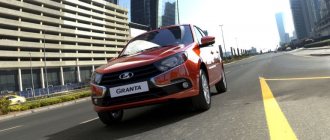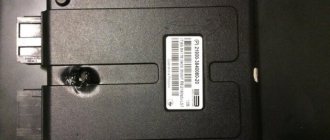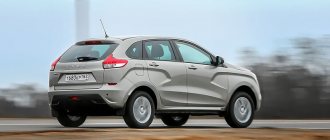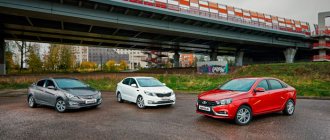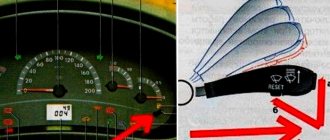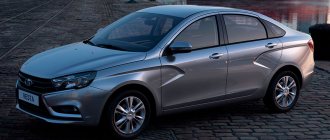Testing methodology
The car in question was destroyed in just one crash test. It was a frontal impact with a 40 percent overlap, and the car itself was accelerated to 64 km/h. Let us clarify once again - here we are talking about equipment 21942-42, equipped with pyrotechnic belt pretensioners. The wheels in this configuration are made of light alloy, which, in turn, could also affect the result.
Station wagon Kalina-2 Lux, photo from the official website
After gaining speed, the station wagon body encounters an obstacle that covers 40% of the space and is located on the driver’s side. This method of testing a car is close to the EuroNCAP methods used for a long time in Europe. What happened as a result is described in the next chapter. In fact, the Lada Kalina car received 3 stars out of 4 possible, which is not so bad. The Granta in the sedan body did not earn much more points, but it was tested using a similar method.
Crash test procedures
European cars are crashed according to the special EuroNCAP program, Japanese cars - according to JNCAP, in Australia - according to ANCAP. There is no own program for Russian cars. The emergency testing procedure is not the cheapest undertaking. In the case of the Lada Kalina, the crash test results conducted by the AvtoVAZ plant are not publicly available. Tests are carried out by independent and non-governmental organizations under the more loyal ARCAP program, since under the same European system a domestic car is unlikely to score good points.
This type of crash test involves the Lada Kalina hitting an obstacle with its front end at a speed of 64 km/h. A collapsible aluminum barrier is used as an obstacle. This simulates the front of another passenger car.
Statistically, frontal collisions occur directly head-on infrequently, so the test is made as close to reality as possible. This means that the impact occurs with a displacement. The contact is made by part of the front, usually on the driver's side. This is how a head-on collision of two cars of approximately the same mass and size is simulated at a total speed of 110 km/h (55 km/h for each vehicle).
Two Hybrid III dummies are placed in the cabin and fastened with seat belts, since tests without belts are meaningless. Sensors are installed on the dummies that record the resulting overloads on the neck, chest, knees, hips, head, shoulders and shins of the dummies upon impact. Using the results of these tests, experts calculate the possibility of injury to the driver and passenger, but only if there are living people in the place of the dummies.
In addition to private organizations, testing of the Lada Kalina is carried out by the impact testing laboratory of the VAZ plant and at the test site in Dmitrov.
Test result
It can be stated that in Kalina-2 with an automatic transmission, the driver’s shins may suffer. The head of the mannequin, which was in the driver's seat, also received serious mechanical stress. But the passenger, who was on the right side of the driver, was fine after the impact. The following diagram illustrates the words:
One dummy was damaged after a frontal impact
Let us clarify what exactly we were able to observe from the test results:
- The brake pedal offset into the cabin is 141 mm;
- Steering wheel offset – 98 mm;
- Change in the geometry of the doorway on the left (maximum value) – 55 mm.
Now let's look at what happened to the mannequins.
| Type of damage | Implications for the driver | Passenger value |
| Head Injury Index (HIC) | 540 | 340 |
| Bending moment of forces acting on the neck, Nm | 28 Nm | 15 Nm |
| Rib compression, mm | 28 mm | 22 mm |
| Load on the femur, kN | 1.5 kN | 1.2 kN |
| Shin injury rate | 0,72 | 0,3 |
The question remains of how the load on the mannequin’s head changed from second to second. The answer looks like this:
Head load for passenger and driver
The minimum acceleration at which a concussion is recorded is 90-100 g. In general, a trip on Kalina-2 does not threaten anything like this, unless you exceed the speed limit.
Even with concussions, loss of consciousness is rare. However, these words are not a reason for violating the speed limit.
Now let’s compare the obtained figures with the crash test result of another car – the Lada Granta Standard. The rate of damage to the lower leg, for example, turns out to be lower there than indicated in our table. Its value is 0.52 for the driver and 0.41 for the passenger. Perhaps the presence of automatic transmission in LADA cars makes its own adjustments.
Crash test Kalina 2
AVTOVAZ has become boring these days. The further the hand of the Renault-Nissan alliance extends over the Russian enterprise (now they have a 25% stake), the better and more beautiful its cars become. What have we come to! Now even the phrase “review” in relation to models from Togliatti does not sound like the name of some new French dish. In this situation, the comedians from the Comedy Club and Crooked Mirror should be pitied the most - they will now have to strain their imagination much more, because jokes about the poor quality of the domestic auto industry are becoming more and more far-fetched, and LADA Kalina 2, stumbling over its childhood syndromes, tried as hard as it could confirm this.
I arrived at the assembly plant in Togliatti on the day the production of the second generation LADA Kalina was launched. Representatives of the plant say that this is the most “stuffed” car in the history of VAZ. And we believe, because the list of additional options for the top-end “Lux” configuration will include, for a moment, rear parking sensors, rain and light sensors, heating threads for the entire area of the windshield, a navigation system and even ESP! What is the new Kalina made of, why is it better than the old one and who are its competitors, and most importantly, what does “complete mincemeat” mean in the minds of the VAZ people - the slogan under which the test drive of the new product took place?
If you look inside the old and new Renault Logan sedan, then apart from the word “foreign car” you will not be able to feel any other pleasant emotions. It is with this definition that owners of budget cars, including Chinese ones, have and continue to amuse themselves. But inside the LADA Kalina 2 is not only no worse, but even better. The pleasant impression is reinforced not only visually: the buttons and levers are not annoying, like a cheap Chinese toy, and the logic of controlling the touch monitor would be the envy of other Skodas and Volkswagens. Add to this a matured appearance with headlights a la VW Polo, and you get a nice and even quite European image.
The new Kalina is based on the public sector LADA Granta platform with a slightly modernized chassis. There is no longer a sedan version; the model remains in two body types - hatchback and station wagon. The dimensions of the five-door, as well as the size of the wheelbase, have remained virtually unchanged. The length of the hatchback is 3,893 mm, the width is 1,700 mm, the height is 1,500 mm, the wheelbase size is the same as that of the Granta - 2,476 mm. The station wagon is 19 cm longer (4,084 mm) and 0.4 cm higher (1,504 mm), the trunk in the stretched version is, of course, much more spacious - 260 hatchback liters versus 361 universal.
The new model has a stiffer front anti-roll bar, the thickness of which has increased from 22 to 24 mm. In versions with a manual transmission there are front and rear suspensions from Granta, on the version with an automatic transmission there are stiffer springs with a changed length and thickness of the rod, borrowed from the first Kalina Sport. As for the shock absorbers, they have not changed - all versions use “struts” produced by SAAZ - like on the Grant, only with the index “21928” instead of “21900” and suspicious “test drive” stickers on test cars.
LADA Kalina 2 has not lost the main advantage of its predecessor - soft suspension, indifferent to all adversities. They cope well with broken asphalt, but add gas - and hello longitudinal rocking. Moreover, the “automatic” Kalina throws no worse than the manual version.
The steering rack, one of the weak points of the first Kalina, received new rigid fasteners to the delight of future owners. Instead of a clamp with a rubber gasket on the left side there is now a cast bracket, a thick bolt and no spacers. This fastening eliminates rack movement and increases the rigidity of the steering system by 25%. At the same time, the level of vibrations on the steering wheel did not increase. But still, the modernized steering with an electromechanical booster brings surprises: while driving, the steering wheel is filled with the necessary weight, but when turning the steering wheel, the car does not immediately obey the driver and turns with a delay. While driving around the training ground, the steering wheel of one of the cars completely jammed. The officials, with the equanimity of a boa constrictor, answered literally the following: “The owners of our cars should not perform such exercises, therefore they should not face problems of this kind either.” In other words, take vegetables to the dacha - behave like a vegetable on the road.
The power range of the LADA Kalina 2 is represented by three engines and two transmissions - manual and new automatic, developed by the Japanese Jatco, which was previously registered on the Grant. The base model for the model is an 8-valve 1.6-liter unit with a capacity of 87 liters. pp., which is combined with a 5-speed manual transmission with cable drive. In addition, a 16-valve 1.6-liter engine producing 98 hp is available. s., presented only with a 4-speed automatic transmission with torque converter, and a power of 106 liters. With. in combination with manual transmission5.
The model with an automatic transmission loses to the version with a manual transmission in the acceleration to “hundreds” in more than two seconds, but this is precisely the rare case when a budget car with an automatic transmission left a more pleasant impression. Gears change smoothly, without jerking, although with quite noticeable dips that occur when you press kickdown and when switching from first to second gear. For more dynamic overtaking on the highway, the automatic transmission has a button to disable overdrive when the transmission does not shift above the third stage. However, the shift mechanism on the “mechanics” is also nothing to blame - the lever travel is moderate, and the precision of gear shifting can be matched by few public sector cars with foreign nameplates.
Ladas have never been distinguished by outstanding sound insulation, and the new Kalina is no exception, despite the fact that VAZ designers have made a lot of efforts to reduce noise and vibration levels in the cabin: new engine mounts have been installed, an additional muffler with a soft bellows has been installed on both types The body has been reinforced with supports for the trunk shelf. And in the “Norma” and “Lux” trim levels, an additional complex is provided, including more plugs for hidden body cavities, an improved sound insulation package for the underbody and front panel. Nevertheless, the noise rushes into all the cracks - from the wheel arches, the engine compartment, the side pillars, and then there are these huge “burdocks” of the side mirrors that create turbulence. But the viewing angle in them, it must be admitted, is amazing, as is the glass area of the car, which provides excellent visibility both forward and to the sides.
What can the most “stuffed” car in the history of the Togliatti plant boast of? Firstly, a multimedia system with a 7-inch color touch screen, available in the top-end “Lux” configuration. In “Standard” and “Norma” there will be an additional glove compartment in place of the touch screen. The new head unit, running the Windows operating system, lacks an archaic CD player, but allows you to play audio and video files and view photos from an SD card. In the future, Tolyatti residents promise to add navigation to the system with GLONASS-GPS chips.
Depending on the configuration, the car’s equipment includes ABS from Bosch, four airbags, power windows on all doors, automatic air conditioning, remote trunk unlocking with a key or a button in the cabin, heated front seats, and a heated windshield is available as an option, as in Ford Focus, heated and electrically adjustable exterior mirrors. Starting from the second half of this year, rain and light sensors and an exchange rate stabilization system (ESP) will be available for a fee.
The protection of the Kalina from corrosion, as it turned out, did not improve - most of the bottom is Movil, and only the sills are treated with anti-gravel, about a third of the body panels are galvanized. Rosneft oil is poured into the engines and gearboxes at the factory, and not technical fluids, which previously only lasted until the first maintenance, which was carried out after a thousand kilometers. The fairly powerful battery with a capacity of 62 Ah remains the same, but installing a more capacious and bulky battery for regions with cold climates will not be difficult; the candles are made in the Czech Republic.
- Spark plugs from the Czech company Brisk
Prices for LADA Kalina 2 will be higher than for the first generation model. Thus, the basic equipment will cost from 324 thousand rubles instead of the current 311.7 thousand. A hatchback in the maximum configuration with an automatic transmission will cost 445 thousand, a station wagon - 452 thousand, not counting options. By the way, AVTOVAZ is not particularly counting on the “stuffed” version; the bulk of sales (up to 85%), according to marketers, will fall on the more affordable “Norma” and “Comfort” trim levels.

